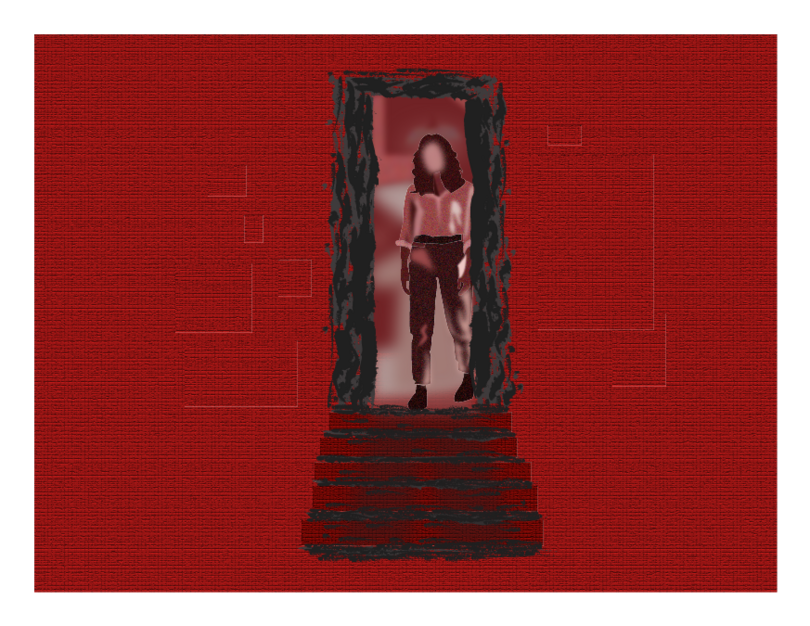‘Barbarian’ bucks the trend of bad horror films with simple yet terrifying premise

Lindy Truitt | Asst. Illustration Editor
“Barbarian” merely alludes to the evil presence in the house, keeping audience members in suspense, and avoiding the mistakes other horror movies have made in recent years.
At the start of “Barbarian,” Tess (Georgina Campbell), the main character, gets out of her car into the pouring rain and enters her rental home in a rundown suburb of Detroit. The camera trails her as if someone or something is following her. Composer Anna Drubich’s haunting score only enhances the eerie feeling.
Once inside the house, Tess finds that the rental was double booked, and she has to share the house with a random stranger, Keith (Bill Skarsgård). The mystery and suspense heightens as the two characters start to figure out what dwells in the house.
While director and writer Zach Cregger’s latest feature is certainly not a haunted house movie, something horrific is still happening in Tess’ rental. The movie uses several other horror movie cliches in line with classics like “The Amityville Horror” and “The Conjuring” to create a twisted, modern and most of all scary film. The movie may not reinvent the wheel when it comes to genre-specific plot devices and storylines, but it uses them in a way that feels fresh and goes against some of the negative trends of present-day horror.
Whether it be through a trailer that gives nothing away or an antagonist that we only really see until the very end, the film intentionally keeps things extremely vague and suspicious to make the truly scary moments feel bone-chilling.
Many horror films nowadays such as “It” (2017) or “Halloween” (2018) are spoiled when the monster or the antagonist shows up very early in the film or in the trailers. But in “Barbarian,” we barely get to see the evil monstrosity that lurks in the labrinth beneath this residence, making the truly scary moments feel bone-chilling.
Even though we only get to see the terrifying creature for about five seconds, we see what it’s capable of when it murders Keith. The creature doesn’t have a backstory, it only offers a jumpscare followed by a quick fade to black, leaving the audience stunned.
This is a prime example of effective horror, as we don’t need to know everything about the antagonist. Recent horror films from the last two years, like “The Conjuring: The Devil Made Me Do It” and “Men,” have way too much melodrama and antagonists that conveniently have a connection to the protagonist. This bogs down the potential for creepiness and hurts the narrative flow of a film.
The stakes in “Barbarian” are easy to understand — this powerful monster is trying to kill Tess and Kieth, and they have no way of stopping it. Horror films tap into basic human instincts much more than any genre in film, which means they don’t need much melodrama. While we do get a creepy vignette of the history of the house and who once owned it, the film offers little explanation on anything else. This movie is only here to creep you out.
The house’s hidden basement serves as a catalyst for creepiness. It includes dungeons that are reminiscent of real-life incidents where a horrific abuser trapped people in a prison-like room. This gives “Barbarian” a realistic edge to it, especially before we see the monster.
Once we get an initial look at our antagonist, the film throws a curveball. We rapidly transition from the basement of the rental outside of Detroit to scumbag Hollywood director AJ (Justin Long) driving in his nice car in California. We get no answers as to what happened to Tess and Keith. The audience is left in confused terror, keeping the momentum and pacing of a horror film going.
He eventually makes his way to the house and finds the basement. The viewer finds out what happens to Tess and we move into the final act, where she and AJ try to escape. Like in most horror movies, the suspense rises tenfold in the final 30 minutes as we find out who survives and who dies.
The ending of “Barbarian” may be standard when it comes to the horror genre, but the film’s last few shots, which feature grisly deaths right after a perfectly timed jumpscare, will leave the viewer shocked and terrified. Rather than including a useless five minutes where the characters live happily ever after, the film’s credits sequence also comes abruptly after the last scenes.
Once again, we don’t need to have an in-depth knowledge of our characters. The ending understands this and never dwells on unnecessary character development growth. “Barbarian” is a story of flawed people simply trying to survive a presence they didn’t think possible.




